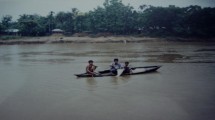Abstract
The aim of this work was to investigate the effect of a continuous food supply on the oxygen consumption of young Mediterranean yellowtails (Seriola dumerili Risso, 1810) during the photophase period (14LL:10DD). Four groups with six fish each, weighing individually approx. 600 g, were distributed into open 2 m3 quadrangular fibreglass tanks, and fed with commercial pellets for 60 days. Two of the tanks received a continuous feed supply by means of automatic band feeders (ABF), whilst fish in the other two tanks were fed by hand, twice a day. To improve accuracy in calculating oxygen consumption, the effect of oxygen diffusion between the air and the water was determined by the use of a control tank of similar characteristics, containing no fish. Oxygen consumption instantaneous rate was calculated by the difference between dissolved oxygen concentrations in tanks with and without fish, multiplied by the water flow and divided by the estimated total fish biomass in each tank. In both feeding regimes, an increase in the oxygen consumption levels after feeding commencement was observed. The amplitude, however, was lower and the duration of feeding effect was higher in the group fed by ABF.
Similar content being viewed by others
References
Abbott J.C. and Dill L.M. 1989. The relative growth of dominant and subordinate juvenile steelhead trout (Salmo gairdneri) fed equal rations. Behaviour 108: 104-113.
Beamish F.W.H. and McMahon P.D. 1988. Apparent heat increment and feeding strategy in walleye, Stizostedion vitreum vitreum. Aquaculture 68: 73-82.
Bergheim A., Seymour E.A., Sanni S., Tyvold T. and Fivelstad S. 1991. Measurements of oxygen consumption and ammonia excretion of Atlantic Salmon (Salmo salar L.) in commercial-scale, single-pass freshwater and seawater landbased culture systems. Aquacultural Engineering 10: 251-267.
Boyce S.J. and Clarke A. 1997. Effect of body size and ration on specific dynamic action in the Antarctic plunderfish, Harpagifer antarcticus Nybelin 1947. Physiological Zoology 70 (6): 679-690.
De la Gándara F., García-Gómez A. and Jover M. 2002. Effect of feeding frequency on the daily oxygen consumption rhythms in young Mediterranean yellowtails (Seriola dumerili). Aquacultural Engineering 26 (1): 27-39.
Grayton B.D. and Beamish F.W.H. 1977. Effects of feeding frequency on food intake, growth and body composition of rainbow trout (Salmo gairdneri). Aquaculture 11: 159-172.
Guinea J. and Fernández F. 1997. Effect of feeding frequency, feeding level and temperature on energy metabolism in Sparus aurata. Aquaculture 148: 125-142.
Halberg F., Tong Y.L. and Johnson E.A. 1967. Circadian system phase. An aspect of temporal morphology; procedures and illustrative examples. In: Von Mayersbach H. (ed.), The Cellular Aspects of Biorhythms. Springer, Berlin, pp. 20-48.
Hamada A. and Maeda W. 1983. Oxygen uptake due to specific dynamic action of the carp, Cyprinus carpio. Japanese Journal of Limnology 44 (3): 225-239.
Jobling M. 1982. Some observations on the effects of feeding frequency on the food intake and growth of plaice, Pleuronectes platessa L. Journal of Fish Biology 20: 431-444.
Jobling M. 1983. Effect of feeding frequency on food intake and growth of Artic charr, Salvelinus alpinus L. Journal of Fish Biology 23: 177-185.
Jobling M. 1985. Physiological and social constraints on growth of fish with special reference to artic charr, Salvelinus alpinus. Aquaculture 44: 83-90.
Jorgensen E.H., Christiansen J.S. and Jobling M. 1993. Effects of stocking density on food intake, growth performance and oxygen consumption in Artic charr (Salvelinus alpinus). Aquaculture 110: 191-204.
Lucas M.C. and Priede I.G. 1992. Utilization of metabolic scope in relation to feeding and activity by individual and grouped zebrafish, Brachydanio rerio (Hamilton-Buchanan). Journal of Fish Biology 41: 175-190.
Ruohonen K. 1986. Biological models related to automatic control in aquaculture. A case study: automatic feeding control. In: Automation and Data Processing in Aquaculture. Pergamon Press, Trondheim, Norway, pp. 75-80.
Sakakura Y. and Tsukamoto K. 1997. Effects of water temperature and light intensity on aggressive behaviour in the juvenile yellowtails. Fisheries Science 63 (1): 42-45.
Sakakura Y. and Tsukamoto K. 1998a. Effects of density, starvation and size difference on aggressive behaviour in juvenile yellowtails (Seriola quinqueradiata). Journal of Applied Ichthyology 14: 9-13.
Sakakura Y. and Tsukamoto K. 1998b. Social rank in schools of juvenile yellowtail, Seriola quiqueradiata. Journal of Applied Ichthyology 14: 69-73.
Talbot C., Corneillie S. and Korsoen O. 1999. Pattern of feed intake in four species of fish under commercial farming conditions: implications for feeding management. Aquaculture Research 30: 509-518.
Watanabe K., Aoki H., Hara Y., Ikeda Y., Yamagata Y., Kiron V., Satoh S. and Watanabe T. 1998. Energy and protein requirements of yellowtail: a winter-based assessment at the optimum feeding frequency. Fisheries Science 64 (5): 744-752.
Watanabe K., Aoki H., Sanada Y., Hidaka E., Kimura H., Yamagata Y., Kiron V., Satoh S. and Watanabe T. 1999. A winter-based assessment on energy and protein requirements of yellowtail at the optimum feeding frequency. Fisheries Science 65: 537-546.
Watanabe K., Kuriyama I., Satoh K., Kiron V., Satoh S. and Watanabe T. 2001. Further clarification of winter energy and protein requirements at the optimum feeding frequency for yellowtail. Fisheries Science 67: 90-103.
Yager T. and Summerfelt R.C. 1993. Effects of fish size and feeding frequency on metabolism of juvenile walleye. Aquacultural Engineering 12: 19-36.
Author information
Authors and Affiliations
Corresponding author
Rights and permissions
About this article
Cite this article
De La Gándara, F., Jover, M. & García-Gómez, A. Effect of Continuous Food Supply on the Oxygen Consumption of Young Mediterranean Yellowtail (Seriola dumerili Risso, 1810). Aquaculture International 12, 205–213 (2004). https://doi.org/10.1023/B:AQUI.0000032081.04020.51
Issue Date:
DOI: https://doi.org/10.1023/B:AQUI.0000032081.04020.51




